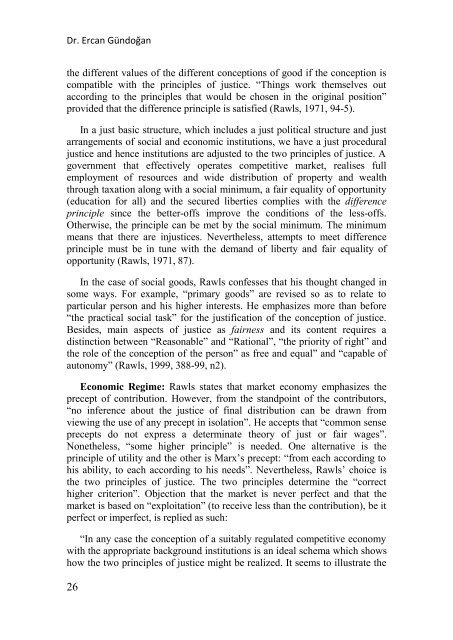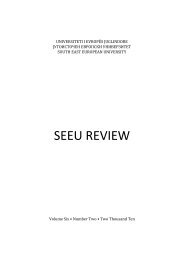SEEU Review vol. 5 Nr. 2 (pdf) - South East European University
SEEU Review vol. 5 Nr. 2 (pdf) - South East European University
SEEU Review vol. 5 Nr. 2 (pdf) - South East European University
You also want an ePaper? Increase the reach of your titles
YUMPU automatically turns print PDFs into web optimized ePapers that Google loves.
Dr. Ercan Gündoğan<br />
the different values of the different conceptions of good if the conception is<br />
compatible with the principles of justice. “Things work themselves out<br />
according to the principles that would be chosen in the original position”<br />
provided that the difference principle is satisfied (Rawls, 1971, 94-5).<br />
In a just basic structure, which includes a just political structure and just<br />
arrangements of social and economic institutions, we have a just procedural<br />
justice and hence institutions are adjusted to the two principles of justice. A<br />
government that effectively operates competitive market, realises full<br />
employment of resources and wide distribution of property and wealth<br />
through taxation along with a social minimum, a fair equality of opportunity<br />
(education for all) and the secured liberties complies with the difference<br />
principle since the better-offs improve the conditions of the less-offs.<br />
Otherwise, the principle can be met by the social minimum. The minimum<br />
means that there are injustices. Nevertheless, attempts to meet difference<br />
principle must be in tune with the demand of liberty and fair equality of<br />
opportunity (Rawls, 1971, 87).<br />
In the case of social goods, Rawls confesses that his thought changed in<br />
some ways. For example, “primary goods” are revised so as to relate to<br />
particular person and his higher interests. He emphasizes more than before<br />
“the practical social task” for the justification of the conception of justice.<br />
Besides, main aspects of justice as fairness and its content requires a<br />
distinction between “Reasonable” and “Rational”, “the priority of right” and<br />
the role of the conception of the person” as free and equal” and “capable of<br />
autonomy” (Rawls, 1999, 388-99, n2).<br />
Economic Regime: Rawls states that market economy emphasizes the<br />
precept of contribution. However, from the standpoint of the contributors,<br />
“no inference about the justice of final distribution can be drawn from<br />
viewing the use of any precept in isolation”. He accepts that “common sense<br />
precepts do not express a determinate theory of just or fair wages”.<br />
Nonetheless, “some higher principle” is needed. One alternative is the<br />
principle of utility and the other is Marx’s precept: “from each according to<br />
his ability, to each according to his needs”. Nevertheless, Rawls’ choice is<br />
the two principles of justice. The two principles determine the “correct<br />
higher criterion”. Objection that the market is never perfect and that the<br />
market is based on “exploitation” (to receive less than the contribution), be it<br />
perfect or imperfect, is replied as such:<br />
“In any case the conception of a suitably regulated competitive economy<br />
with the appropriate background institutions is an ideal schema which shows<br />
how the two principles of justice might be realized. It seems to illustrate the<br />
26

















